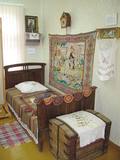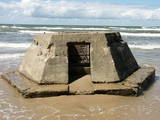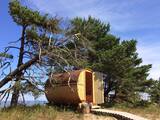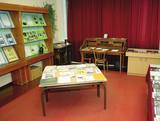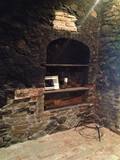| Nr | Nosaukums | Apraksts |
|---|---|---|
|
Viens no lielākajiem Igaunijas karsta laukiem. Tā interesantākais dabas veidojums ir unikālā Raganu aka, pa kuru pavasara palos (ne katru gadu un salīdzinoši īsu laika brīdi!) izplūst pazemes upes ūdeņi, veidojot neparasti spēcīgu karsta avotu, kura izvirstais ūdens daudzums var sasniegt 100 l/s.
|
||
|
“Amatnieku namiņš” ir saimnieces izlolota sirds lieta, jeb vieta, kur vienkopus atrodami daudz un dažādi vietējo un apkārtnes novadu amatnieku un mājražotāju darinājumi. Tējas, garšvielas, ievārījumi, dažādi smēriņi, adījumi, kokdarbi, pinumi, ziedi un ziedu kārbas, sveces, krūzes un daudz kas cits ir atrodams tieši “Amatnieku namiņā”. |
||
|
Ģimenes uzņēmums Svētes pagastā, netālu no Jelgavas. Kopš 2019.gada šeit top dažādi Latvijas priežu produkti, kas vērtīgi kā imunitātei, tā arī veselībai. Mītavas Čiekurs produktu galvenā sastāvdaļa ir Parastā priede (Pinus sylvestris). Tā bagāta ar ēterisko eļļu, sveķiem, miecvielām, C vitamīnu u.c. vērtīgām vielām. Tiek gatavotas priežu čiekuru karameles, čiekuru sīrupa zefīri, želejkončas, priežu čiekuru zapte, karamelizēti čiekuri sīrupā, šokolādē, kā arī priežu pumpuru sīrups un tēja. Ekskursija norisinās 90-120 minūtes, kuru laikā atraktīvais saimnieks Reinis pastāstīs par uzņēmuma vēsturi, dalīsies receptēs, pagatavos katram apmeklētājam gardu dāvanu (čiekuru marmelādi), kā arī protams- varēs degustēst dažādos priežu produktus. Papildu pirms vai pēc ekskursijas iespējams ieturēties ar uz ugunskura gatavotu pupiņu zupu ar lauku kūpinājumiem, soļanku vai biešu zupu. Tūristus uzņem nupat uzbūvētajā ekskursiju telpā- Čiekurnīcā. Uzņemt var līdz pat 60 interesentiem reizē. |
||
|
Katra mēneša otrajā sestdienā (iepriekš vienojoties – arī citi laiki) saimnieka klātbūtnē katrs pats var iemēģināt prasmes zivju kūpināšanā, kam seko pagatavoto zivju degustācija. |
||
|
Maltas Vēstures muzejs. Ekspozīcija „
Maltas pagasts gadsimtos no Rozentovas
līdz Borovajai un Maltai”. Piedāvājam iepazīt sadzīves priekšmetus, darbarīkus,
mākslas priekšmetus, naudas zīmju kolekciju. Ekskursija ārpus muzeja
„Kur Maltas upe līkumus met”.
Darba laiks: P. - Piekt: 9.00 – 17.00, S., Sv : slēgts |
||
|
Atrodas Neretas centrā, Rīgas ielā 2. Baznīcu (baroka stils ar vēlīnās gotikas iezīmēm) uzskata par vienu no vecākajiem Zemgales dievnamiem. To cēla laikā no 1584. - 1593. g. pēc grāfa Vilhelma fon Eferna iniciatīvas (pārbūvēts 1679. g.). Baznīcā atrodas Vilhelmam fon Efernam un Georgam fon Efernam veltīti no akmens kalti kapakmeņu ciļņi, kas darināti 16. gs. beigās (G. Eferna kapakmens – izcilākais agrīnā ziemeļu manierisma mākslas darbs Latvijā), P. Handlera darināta altārglezna (1863. g.), R. Knaufa būvētas ērģeles (1893. g.), E. Baijermana veidotas logu vitrāžas (1900. g.), 17. un 19. gs. griestu lukturi. Baznīcas apmeklētāji var apskatīt Neretas un tās apkārtnes ainavu no 38,6 m augstā savdabīgā baznīcas astoņstūru torņa.
|
||
|
Uz iespaidīgo Gaujas senleju, tās dabas un kultūrainavu labākie skatu punkti paveras no Paradīzes (Gleznotāju) kalna, Siguldas pilsdrupām, Gaisa trošu ceļa, Panorāmas rata, Ziediņa un Pilsētas kalnu slēpošanas trasēm, Bobsleja un kamaniņu trases apkārtnes, Ķeizarskata, Velnalas klinšu skatu laukuma, Siguldas kalnu velomaršruta (Gaujas labais krasts, īpaši bezlapu periodā), Krimuldas pilsdrupu apkārtnes, Dainu kalna un Turaidas pils torņa.
|
||
|
Maršruts piemērots aktīviem braucējiem, kam interesē Ķemeru nacionālā parka dabas un kultūrvides daudzveidība. Ķemeru nacionālais parks (dibināts 1997. g.) veidots g.k. mitrāju – seklās Rīgas jūras līča piekrastes, aizaugošo piejūras ezeru, purvu, mitro mežu (dumbrāju u.c.) un palieņu pļavu - kā nozīmīgu daudzu augu (~ 25 % no Latvijas Sarkanā grāmatā ierakstītajām sugām) un dzīvnieku, īpaši - ligzdojošo un migrējošo putnu dzīves vietu aizsardzībai. Parka teritorijā atrodas viens no lielākajiem Latvijas purviem – Lielais Ķemeru tīrelis. Purvu masīvi ir nozīmīga sērūdeņu veidošanās un izplūdes vieta, kā arī ārstniecībā izmantojamo dūņu atrašanās vieta, kas bija kādreiz tik populārā Ķemeru kūrorta izveides pamats. Maršruta informācija no Latvijas Lauku foruma |
||
|
"Untumos" uztur un atjauno zirgu ganāmpulku, kā arī iegādājas zirgus, kuri atbilst vēsturiski veidotās Latvijas zirgu šķirnes prasībām. Te var iegūt jāšanas iemaņas instruktora pavadībā ierobežotās platībās un apvidū. Vasarās piedāvā vizināšanos ratos, ziemā – pajūgā. Zirgus izmanto kāzās u.c. svinīgos pasākumos. |
||
|
Atrodas Lielvārdes parkā pie Rumbiņas ietekas Daugavā. Līdzīgi kā citur, arī šeit 13. gs. pirmajā pusē bīskapa pili cēla nodedzinātās lībiešu koka pils vietā. Mūra pili nopostīja Livonijas kara laikā - 1577. g. Tikai 1987. g. notika drupu konservācija. Lielvārdes parka veidošanu uzsāka 19. gs. beigās Lielvārdes muižas barona Artura fon Vulfa vadībā. Sagaidot eposa „Lāčplēsis” simtgadi tajā izvietoja sešpadsmit no ozolkoka veidotas skulptūras (t.s. Skulptūru dārzs) (autori V. Ansavs, P. Mellis, Ē. Delpers, A. Dauvarte). Aiz pilsdrupām Daugavas krastā ir stāva krauja ar dolomīta iežuatsegumu. Līdz HES ūdenskrātuvei var nokļūt pa kāpnēm. Lielvārdes muižas pils līdz mūsdienām nav saglabājusies. |
||
|
Painted in dark colours, this building dates back to the 17th century (the square around it is cited in documents). The city’s first prison was in the cellar of the building, and the square was historically a place for residents of the city could gather and suffer punishments. A pole of shame was at the south-eastern corner of the square. The building now houses the Kuldīga Tourism Information Centre and a workshop for weavers. Visitors can purchase products and souvenirs from Kurzeme and watch weavers at work. |
||
|
Atrodas Tirdzniecības kanāla dienvidu krastā, kas padomju laikā bija slēgta zona ar pierobežas režīma statusu. Tagad lieliska pastaigu vieta, kur var vērot kuģīšus un jahtas. Promenādes visā garumā izvietojušies vēsturiskie spīķeri. Šeit meklējami krodziņi, viesnīcas, mūzikas klubs, mākslas galerija un Dzintara pulkstenis. |
||
|
First the route goes to the birch juice and wine maker where you can taste this traditional and refreshing drink, then a goats farm where to taste various diary products and see the animals. Further on head to Sigulda with the Olympic Bobsled Track and three medieval castles located on the banks of the river Gauja - Sigulda, Turaida and Krimulda. There is also a good network of picturesque walking trails. Then explore historic village of Ligatne established around the Paper Mill and visit local craftmen located in one of the caves typical for the area. Cesis is charming town with mighty medieval castle ruins and New Castle. Visit hemp grower and try the hemp prepared traditional way. Enjoy Koni Mill where wool is processed with old fashioned machines and warm blankets are hand-made. Visit crafts studio at Staicele and try to spot the stork colony with more that 30 nests along the road. At Mazsalaca where there is a nature park with trails featuring beautiful steep sandbanks of the river Salaca. The river is also famous for its lampreys and further on the route you could see the weirs for traditional lamprey catching. At Saulkrasti walk the Dune trail and enjoy the beach. Further on visit cranberry swamps where you can taste healthy berry in some form depending of the season. Visit elegant Birini Manor with huge park and great restaurant and return to Riga. |
||
|
All that’s left of the battery today are the ruins of a cement blockhouse which have slid all the way down to the beach because of years of abuse by the wind and the waves. It is an interesting monument to history with a long-term fate that we can guess at – it will disappear under the sea.
|
||
|
"Anima Candles" sveces ir roku darbs. Svecēm pieejami vairāki dizaini, kas variē gan krāsās, gan izgatavošanas metodē. Krāsu un smaržu klāsts ir plaši pieejams. Tās izgatavotas no pārtikas rūpniecībā izmantojamā parafīna vai ekoloģiskās sojas. Sveču ražotnē tiek piedāvātas sveču liešanas meistarklases.
|
||
|
Atrodas 0,5 km ziemeļaustrumos no Dzērbenes baznīcas, ceļa otrajā pusē. Vizuāli izteiksmīgs pilskalns ar 50 x 50 m lielu plakumu, kura kultūrslānī atrastas vēlā dzelzs laikmeta apmetnes atliekas. Pilskalna rietumu nogāzē ir izveidots ceļš, pa kuru nonāksim līdz tā plakumam ar estrādi. |
||
|
Happiness House (Laimes maja) is a recreation place situated in a very beautiful place on the seashore – on Cape Kolka. Here you will have a chance to relax, watch sunrises and sunsets, enjoy the sea, quiteness and peace. |
||
|
Local History Museum of Bērzgale was founded in 1988. There is
the memorial room of writer Antons Rupainis (1906 – 1976), the exposition of municipality history, its famous
people and cultural-historical traditions.
Working hours: Mon– Fri : 9.00 – 12.00,13.00 – 17.00, Sat., Sunday : on request |
||
|
The Jūrkalne People's Centre is the main gathering place for Suiti people and is in a former saloon that was built around 1875. Major restorations were conducted in 2011. The centre offers various events, there is an exhibition hall for visitors, and the "Maģie Suiti" ethnographic ensemble and other amateur ensembles are active there. If you want to meet the Suiti and learn about their traditions, contact the centre in advance. |
||
|
This is a cemetery that was originated in the Middle Ages and used until the beginning of the 20th century. A mossy stone fence surrounds the cemetery. Interesting elements in the cemetery include the grave of Heinrihs Jakobsons (1832-1911), who was the first schoolteacher in Mazirbe (the old metal cross is to the left of the main gate), a pine tree of national importance and has a circumference of 3.17 metres (during the Soviet Union someone drilled a hole in the trunk of the tree to access honey), the grave of Niks Freimanis (1845-1908), who is said to have been the prototype for a character in a story and play by Marģers Zariņš, and the Werewolf Grave, which relates to countless ghost stories, including the claim that it is the only known gravesite of a werewolf in Latvia. |
||







